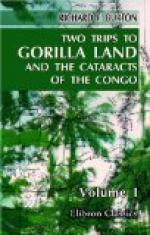And now the long intervals between travellers’ accounts wax shorter. The well-known writer, Bowdich, before quoted, published, in 1819, his hearsay description of the “Ingena,” garnished with the usual native tales. I had the honour of receiving an account of his discovery from his widow, the late Mrs. Lee, who was held the “mother of African travellers,” and whose energy and intelligence endured to the last,—if memory serves me, she referred to some paper upon the subject, written by herself about 1825. Towards the end of 1846, the Rev. Mr. Wilson, founder of the Gaboon Mission, and proto-grammarian of its language, obtained two skulls, which were followed by skeletons, fragmentary and perfect. He sent No. 1, measuring, when alive, 5 1/2 feet in height, and 4 feet across the shoulders, to the “Natural History Society” of Boston. He evidently has a right to boast that he was “the first to call the attention of naturalists to the ‘Njena.’” His colleague, Dr. Thomas Savage, and Professor Jeffries Wyman called the new animal by the old name of gorilla, suffixing it to the “Troglodytes” which Geoffrey de Saint-Hilaire, reviving Linnaeus, had proposed in 1812. In 1847, Dr. Savage published in the “Journal of Natural History” (Boston) the result of his careful inquiries about the “Enge-ena” and the “Enche-eko.” In 1852, this information was supplemented by Dr. Ford, also of the Gaboon Mission, with a “Paper on the Gorilla,” published in the “Transactions of the Philadelphian Academy of Sciences.”
M. du Chaillu first had the honour of slaying the gorilla in its native wilds. I saw his trophies in the United States in 1859; and the sensation which they subsequently created in London (1861-1862) is too recent to require notice. Unfortunately the specimens were mutilated and imperfect. Mr. R. B. N. Walker, agent of Messrs. Hatton and Cookson at the Gaboon River, was the first to send home a young specimen bodily, stowed away in spirits; two boiled skeletons of large grey animals, whose skins I saw at the factory, and rum-preserved brains, intestines, and other interesting parts, which had vainly been desired by naturalists. Mr. W. Winwood Reade spent five active months in the Gorilla country in 1862: Major Levison also visited the river, but their hunting was as unsuccessful as mine; whilst, in 1863, Major (now Colonel) De Ruvignes is reported to have been more fortunate. Since that time gorillas have been killed by the French chasseur.
The young Troglodyte has often been captured. The usual mode is to fell the tree, and during the confusion to throw a cloth over its head; the hands are then pinioned behind, and a forked stick is fastened under the chin to prevent the child biting. I should prefer, for trapping old as well as young, the way in which bears are caught by the North American backwoodsman,—a hollowed log, with some fruit, plantains for instance, floating in a quant. suff. of sugar, well sugared and narcotized.




